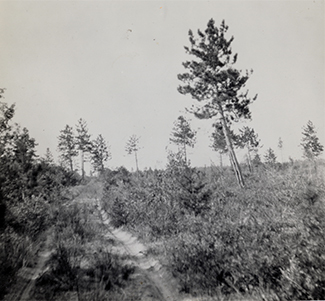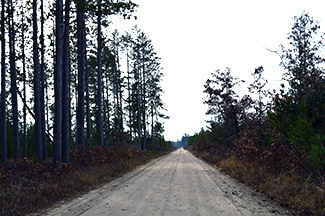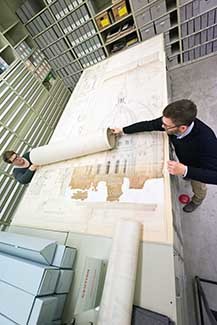Calling all Michiganologists
By TOBI VOIGT
Michigan Department of Natural Resources

Many residents and visitors to our state may not know that Michiganology is a website, a product line and the study of all things Michigan.
Each year, thousands of researchers looking for documents, photographs and maps that tell Michigan’s stories visit the Archives of Michigan in Lansing, which is part of the Department of Natural Resources’ Michigan History Center.
In addition, tens of thousands of visitors visit the archives’ online collections.
This fall, the archives launched Michiganology.org, a new website that makes more than 10 million records available online, free of charge. These documents include death and naturalization records, which family researchers use to learn more about their family’s history.
The archives also hold records relating to the history of the DNR.
For example, between 1927 and 2012, the department’s wildlife division conducted an 85-year photography project to capture annual images on DNR-managed land across the state from the same position.
The photographs document changes to landscapes over time and are a valuable resource to biologists and others seeking to understand changes in wildlife habitats.
|
|
These photographs now reside within the Archives of Michigan.
“Michiganology’s mission is to foster curiosity, enjoyment and inspiration rooted in Michigan's stories,” said state archivist Mark Harvey. “The new website is where visitors become ‘Michiganologists,’ people who are curious about Michigan, share its stories and understand and take pride in Michigan's unique identity.”
|
|
 |

The new website replaces “Seeking Michigan,” the archives’ first online platform for sharing digital records.
SeekingMichigan.org went live in March 2009 with nearly 1 million records.
Over the past decade, the software used to develop the Seeking Michigan website has aged and become difficult to update. Moreover, hundreds of thousands of new digital records overloaded the system.
The archives team determined that although Seeking Michigan was groundbreaking, it was time to create a new system with more capacity that could better serve the public.
Beginning in 2012, archives staff began planning a large-scale move of its digital records onto a new platform.
Archives staffers helped Michigan become the first state to adopt the Preservica preservation system, which allows the archives to better preserve digital versions of paper records, as well as the increasing flow of records that are “born-digital.”
“With more and more documents being created on computers, and with a never-ending flow of information being shared online in social media platforms, it was critical that the archives adapt its systems and processes to ensure that these records are preserved for the future,” said Jessica Harden, state government records archivist, who spearheaded the archives’ initiatives to preserve social media accounts for public officials, including immediate past Gov. Rick Snyder.
In addition to moving its digital records into the new Preservica system, archives personnel embarked on developing the Michiganology.org website that provides broad public access to the state’s records.
|

Engagement archivist Jill Arnold took the lead on the website’s development, which included creating three different methods to search for records. The variety of search options accommodate the ways people prefer to look for information.
Arnold also worked with Michigan History Center education and engagement staff to develop articles and activities on Michigan history topics that also are featured on the website.
“While our biggest priority was making the state’s records available online, we also wanted Michiganology to become the home for Michigan history information,” Arnold said. “The website includes more than 50 short articles about interesting items in the archives, little-known stories about people, places and events, and more. We are adding more stories every week.”
The website is also the new home for the Michigan History Center’s K-12 educational resources. The “Learn” section of the website contains grade-level appropriate reading materials and activities for students, as well as teacher background information on content related to Michigan state teaching standards.
“We are just starting to develop these new resources, based on feedback we have received from teachers,” said Rachel Clark, the center’s education specialist. “We started with Michigan’s statehood era, which is a key part of third-grade learning standards. As the site develops, we will be adding more topics for all grade levels.”
|

The new website also includes the archives’ Michiganology store.
In 2009, the archives began reproducing photographs, maps and other archival materials as high-quality prints, puzzles and magnets. Items are made by staff and volunteers in a special workshop at the Michigan History Center in Lansing. The proceeds from the sales support the educational and public programs at the Michigan History Center.
Staffers are continually monitoring and making improvements to the Michiganology website. Plans for an enhanced document viewer and more robust search capabilities are in development.
“Moving 10 million records is a major endeavor, and there have been some minor glitches,” Arnold said. “We will continue to work out bugs, listen to users and work to better serve the public as we fine-tune the website.”
Staffers also are working to add new resources to the website. They continue to streamline and upload collections indexes, which allow users to see records across collections and research more efficiently.
An ongoing partnership with FamilySearch.org is digitizing, indexing and making available online thousands of new local government records, including more than 7 million naturalization records.
“Michiganology.org is an important tool to connect Michiganders to public records, education resources and the history of the state,” Harvey said. “It is the best place to learn about the state you love. We encourage you to explore it and find your story. And we are here to help.”
|
Check out previous Showcasing the DNR stories in our archive at Michigan.gov/DNRStories. To subscribe to upcoming Showcasing articles, sign up for free email delivery at Michigan.gov/DNR.
/Note to editors: Contact: John Pepin, Showcasing the DNR series editor, 906-226-1352. Accompanying photos and a text-only version of this story are available below for download. Caption information follows. Credit Michigan Department of Natural Resources, unless otherwise noted.
Text-only version of this story.
Capitol dome: The new Michiganology website provides access to historical documents, like the original architectural drawings of the state capitol building, which are too large and delicate to be handled regularly.
Falcon: Michiganology.org includes the photo archive of the Michigan Department of Natural Resources. In this image, taken around 2006 by former DNR photographer David Kenyon, a Wildlife Division employee holds a peregrine falcon chick after banding. Young peregrine falcons are banded so they can be identified later should they turn up in another state or be found injured.
Family search: A partnership with Family Search has enabled the Archives of Michigan to digitize Wayne County probate records using a state-of-the-art camera and computer imaging system. The records will be made available online once processing is complete.
Puzzles: Archives of Michigan staff members make puzzles from digitized maps, like this birds-eye view of Ann Arbor from 1880. They are available for purchase on the Michiganology.org website. All proceeds benefit educational programs at the Michigan History Center.
Roscommon 1924: In 1924, Michigan Department of Natural Resources photographers documented a scene on a trail road in Roscommon County as part of its Wildlife Camera Point project. Staffers revisited this site regularly over 80 years to photograph and document changes to the landscape. The images are available on the Michiganology website.
Roscommon 2012: In 2012, the last photograph of the trail road in Roscommon County, first photographed in 1924, was taken as part of the Wildlife Camera Point Project./
|